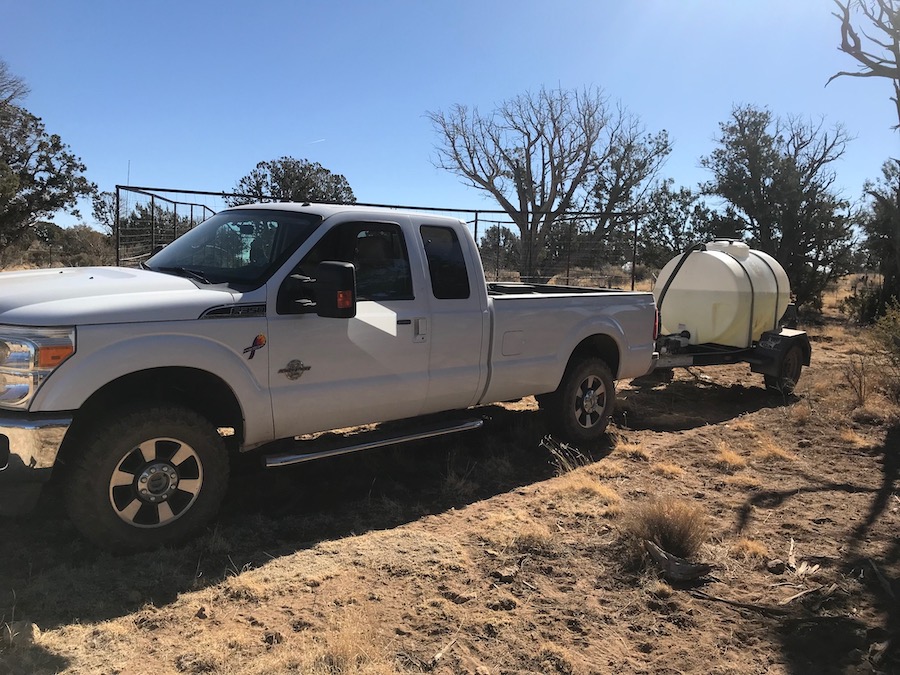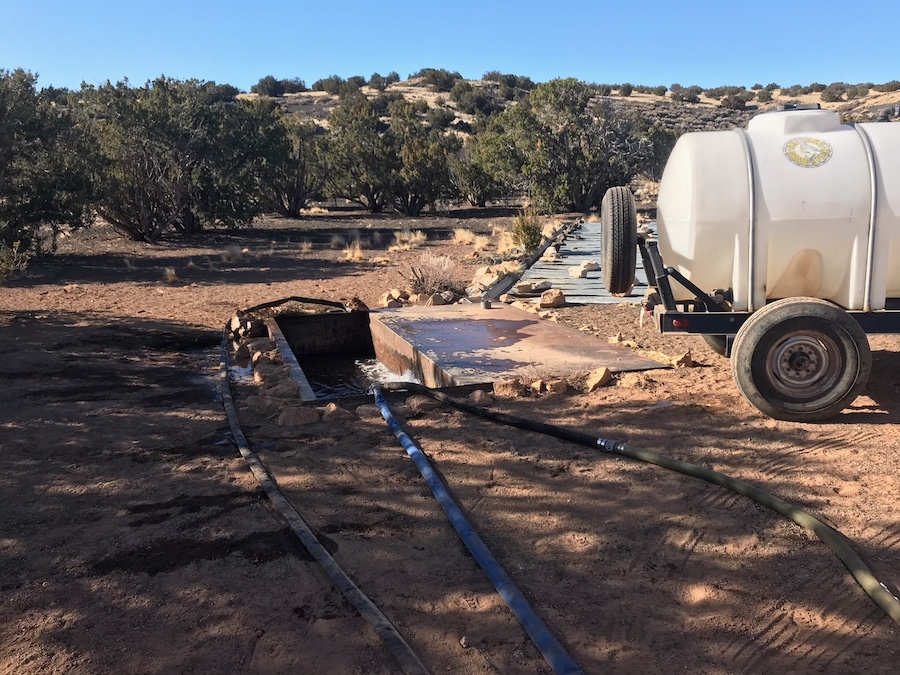On Saturday, June 17 three of us went to Butcher Knife Tank. We surveyed the land and figured out the best place to put the catchment system. We then started measuring and marking/staking the perimeters of the excavation hole to be dug for the tanks to sit in as well as marking out the boundaries of the apron. This project was planned to be a 48’x48’ apron, but we realized the best size for the area would be 24’x96’, which would give us the same amount of surface area, as well as utilizing the lay of the land better. Using laser levels and a backhoe, we dug out the hole throughout the day. We had to move a couple of dead trees out of the way from previous fires, but largely left the surrounding area untouched. We will be returning to the area on June 23-25 and again on July 7-9 to start building the catchment system.
Returning to the job site on the weekend of June 23-25, myself along with 12 other volunteers worked to set 4 tanks in the excavated pit. These tanks have to bet set on top of ¾” mats, completely level, and brought in by heavy equipment. We also worked through the evening on Friday, all day Saturday, and Sunday morning to auger out 33 holes and set poles in concrete. This will serve as the base for the main frame, which consists of 2x2 metal square tubing that will sit on top of the poles we set this weekend. The team worked really hard as this was a big task for one weekend, even braving the swarming gnats, 30 degree night time temps, and windy conditions on some days with blowing dust. Just some of the duties on this job included running a backhoe/loader tractor, running an auger, shoveling dirt, running strings, and mixing concrete. Friendships were formed or strengthened and hunting stories abounded in camp, all while eating some great food. We in total had just over 138 hours of time donated this weekend between all of our volunteers. AES, AZGFD Habitat Partnership Committee, Arizona Elk Society Northern Peaks Chapter, Northern Arizona Mule Deer Foundation, Arizona Antelope Foundation and others had volunteers that came out to lend a hand on this portion of the project as well as help fund this project. We look forward to the upcoming weekends to finish up at this jobsite, which will be ongoing throughout July.
From July 7-9, we went to Butcherknife to begin the third phase of the project, which involved constructing the apron. Over the weekend, we had nearly 20 dedicated volunteers who worked tirelessly. While there were occasional challenges, we managed to accomplish a lot. Some highlights include attaching 2x2 metal square tubing to our poles with the appropriate drainage slope, removing the barbed wire from the entire 400-yard perimeter fence, installing the drinker and running a 3" pipe from the tanks to the drinker, assembling most of the apron framing, and starting to dismantle the older style tank. We enjoyed good food and camaraderie, and even had a surprise visitor in the form of a prairie rattlesnake seeking shade under our water and Gatorade cooler.


Aug 4-6 we were back at Butcherknife hard at work. We were able to finish all but one piece of metal on top of the apron, hang the entry gate on the perimeter fence, cement and set roughly 2/3 of the holes for the perimeter fence, and welded approximately 100 yards of runner onto the perimeter fence. We had a great crew who worked hard all weekend.
It was cool to see that elk and antelope have been utilizing our new drinker. We were even able to see about 10 elk, 4 bulls and some cows/calves in the area. The wildlife are starting to appreciate our work, especially with it becoming more dry in the area. We had a gray fox visit camp one evening, and again had to relocate a rattlesnake. Needless to say after 3 sightings we are watching where we walk!
Thank you to all the volunteers who give their time so graciously, the AZGFD Habitat Partnership Committee, Arizona Elk Society Northern Peaks Chapter, Northern Arizona Mule Deer Foundation, Arizona Antelope Foundation, and others. These groups help to fund this and also send volunteers out to help.
Sept 8-10
After 2 rainouts and a month away from Butcherknife Tank, we were able to reconvene there this weekend. We now have a fully functional water catchment system at this project site! This past weekend we were able to accomplish a lot. This included putting our last piece of tin on the top of the apron, starting to put skirting around the apron, fully plumbing from the gutters back to the tanks, sealing any seams with silicone, backfilling dirt around the tanks and over our 3” pipe, and completing the perimeter fence except for a few stays to be welded in place(at least the fence will keep the cattle out now). The only thing left to do at this site is build the elk exclosure fence and place some more skirting on, but not sure when I will get back up there as I have a couple of other projects to tend to first. It even rained a bit to let us know that our aprons works and catches water. Again I’d like to thank all of our partners in this who help not only fund but also donate time to this project, along with all our all volunteers who have helped out.


